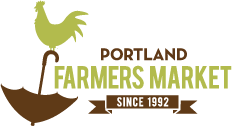Farm to Plate: Part V
On the Sunday after Thanksgiving, when many Portlanders were still lost in the haze of leftover turkey sandwiches, a trio of Portland Farmers Market staffers hit the road for a one of a kind experience: a stewing hen harvest day at Persephone Farm. We invite you to follow their adventure through a series of posts over the next few days that capture the reality and intensity of life on the farm and the reverence that comes with butchering your own dinner.
Farm to Plate: Part V
By Anna Curtin, Amber Holland and Nicki Passerella
When it came time to scald and eviscerate the hen, one of the most important things we learned was to have all the preparations made ahead of time. Before we began, several tables were already set up and cleaned, along with ample buckets for discarded pieces and the chickens themselves once the evisceration was complete. A nearby hose to wash the hens and keep the hot water flowing soon came in handy.
From the chopping block, the hens took a brief dip in hot water to loosen the feathers before evisceration. The first thing to go was the feathers, which are pulled out in the direction of growth. We quickly discovered that the feathers from a bird that is molting at the time of death are much more difficult to pluck because of the new growth coming in.
With Jeff’s guidance, we worked through eviscerating the birds. Once plucked, the next step was to remove the feet, which is done by making an incision at the ankle and bending the foot backward until it is clear where the foot meets the leg. Then the knife follows the path the rest of the way.
After the bird’s feet were removed, a vertical slit was made in the chicken’s skin from the top of the breast bone almost to the neck. Another cut was made horizontally at the shoulders to meet the first, making a “T” shape. Once the opening was big enough, you slide your hand inside the bird and trace your fingers around the inside of the rib cage, loosening any connective tissue. Then, with all the innards in hand, you must pull firmly to release the bird’s digestive tract, heart, kidney, fat, gizzards, etc.
A bowl of ice within reach, we carefully separated the fat and digestive tract from the organ meat. Most of this work is done by hand and it is quite slippery. Eventually, the bowl of ice received the feet, heart, gizzards, and liver, for these can all be cooked and enjoyed! At this point, it was time to give the hens a rinse using a hose with good pressure, which helps out a lot. Once rinsed, the birds were ready to chill on ice before being bagged and distributed to the hen harvest participants.
Eviscerating a hen whose body still carries its own heat, to remove what was recently alive and breathing from a carcass, is truly a remarkable undertaking. Our group of three culled six of the thirty five birds harvested over the course of the day, shepherding each one from field to cooler. As Jeff echoed when he harvested the first bird, we never felt calm, but with this experience, we were given the education and the confidence to humanely kill and process each chicken.
We left the farm much more connected to the source of our sustenance, mindful of the effort and investment – financial, emotional, personal – it takes to bring a living creature to the plate. We were exceedingly grateful to have participated in this community of common purpose – the purpose of thanksgiving, nourishment, and engagement in an interdependent, sustainable food system.
A special thanks to Jeff and Elanor for opening their farm to those who are interested in connecting with their food source. Download Persephone Farm’s recipe for Chicken Cacciatore.



